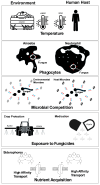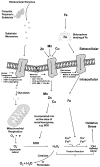An Introduction to the Influence of Nutritional Factors on the Pathogenesis of Opportunist Fungal Pathogens in Humans
- PMID: 40333109
- PMCID: PMC12030028
- DOI: 10.3390/pathogens14040335
An Introduction to the Influence of Nutritional Factors on the Pathogenesis of Opportunist Fungal Pathogens in Humans
Abstract
Fungi such as Aspergillus fumigatus, Candida albicans, and Cryptococcus neoformans are opportunistic pathogens in humans. They usually infect individuals whose immune system is compromised due to either a primary infection, e.g., HIV/AIDS, or as part of treatment for another condition, e.g., stem cell or solid organ transplant. In hosts with a weakened immune system, these fungi can cause life-threatening infections. Unlike true pathogens, opportunistic pathogens do not have specific mechanisms to overcome a healthy host, requiring a different approach to understand how they cause infection. The ability of fungi to adapt to various environmental conditions, including the human host, is critical for virulence. In humans, micronutrient metals, such as iron, are sequestered to reduce serum concentrations, which helps to inhibit microbial growth. Other human tissues may increase metal concentrations to toxic levels to prevent infection by pathogens. The ability of fungi to acquire or detoxify nutrients, such as iron or copper, from the host is essential for the establishment of infection. In this review, the role of fungal nutrition will be discussed in relation to opportunistic fungal pathogens. It will focus on the acquisition of micronutrients, e.g., iron, copper, and zinc, and how this enables these fungi to circumvent host nutritional immunity.
Keywords: aspergillosis; fungal nutrition; mycosis; virulence.
Conflict of interest statement
The authors declare no conflicts of interest.
Figures


References
-
- Smith S.E., Jakobsen I., Gronlund M., Smith F.A. Roles of arbuscular mycorrhizas in plant phosphorus nutrition: Interactions between pathways of phosphorus uptake in arbuscular mycorrhizal roots have important implications for understanding and manipulating plant phosphorus acquisition. Plant Physiol. 2011;156:1050–1057. doi: 10.1104/pp.111.174581. - DOI - PMC - PubMed
Publication types
MeSH terms
Substances
LinkOut - more resources
Full Text Sources
Medical

